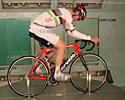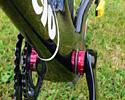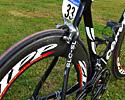
Recently on Cyclingnews.com |
Pro Bikes, July 13, 2007
Fabian Cancellara's Team CSC Cervélo SLC-SL
Team CSC's Swiss powerhouse looks good in yellowBy James Huang in Appoigny, France Team CSC continues its winning ways and has started off this year's Tour de France with a bang. Current world time trial champion Fabian Cancellara was the only rider to complete the opening prologue in less than nine minutes, averaging a blistering 53.7km/h (33.4mph) over the flat 7.9km (4.9mi) course through the streets of London and taking the first maillot jaune in the process. After the Swiss speedster proved himself as one of the best trialists in the world yet again, he reminded the rest of the peloton that he is a threat on the road as well (as if his 2006 win at Paris-Roubaix wasn't enough). Stage 3 looked to finish in a bunch sprint, but Cancellara had other plans: he gave it full gas at a relatively long 750m to go and held off the charging pack of pure sprinters to take the win in spectacular fashion… with his hands on the hoods. Cervélo remains the Team CSC bike sponsor for the 2007, and this year all the riders but one have upgraded to the company's SLC-SL for the entire TdF. As compared to the Soloist Carbon on which it's based (and which much of the team piloted to great success last year), the SLC-SL shaves approximately 200g to bring it under the 1kg mark. Cervélo's R3-SL is even lighter, but the only Team CSC rider to use one is Spaniard Carlos Sastre, whose choice was based more on the R3's more compliant ride than on saving a few grams. With a lighter option easily available and the first mountain stages just days away, why does Team CSC go with the SLC-SL? Cervélo principal Gerard Vroomen offered this explanation: "There are two bikes you can build: the lightest or the fastest (which would be pretty light but not at all costs)… the first would win the 'let's hold our bikes over our head' contest, the second would win the bike race. But to be fair, the first would probably win some races as well, as the majority of frames are of course not aero and not light. And of course there is the Paris-Roubaix aspect, although there is so much comfort engineered into our aero frames now that they wouldn't do too badly on the cobbles either - if they had the tire clearance." Some readers may balk at the idea that an aerodynamic frame can make that much of a difference in a road race, but Vroomen begs to differ as a slippery shape would be advantageous for a much greater percentage of time than light-weight-at-all-costs. "In February we tested Fabian in the wind tunnel on the SLC," he said. "That frame saved him around 3% in drag [combined bike and rider]. That may not sound like much, but in a 1km solo like at the end of Stage 3, that works out to around 10m. Luckily he only needed 9m advantage." For the mostly flat Stage 4, Cancellara augmented his frame's aerodynamics with a particularly deep-section Zipp 808 carbon wheelset. At nearly 1.9m (6' 3") tall, 80kg (176lb), however, and with a power output rivaling most nuclear fission reactors, Cancellara naturally runs his choice in componentry a bit on the safe side when it comes to just about everything else. As with many professional riders, Cancellara prefers the added security of an aluminum handlebar and stem. Surprisingly, however, he also foregoes the de rigueur carbon fiber crankset for FSA's decidedly mid-level (and substantially heavier) Gossamer model. According to Team CSC mechanic Alejandro Torralbo, Cancellara began using the Gossamer cranks during the Spring classics, but grew more comfortable on them than carbon ones because he feels that they're stiffer. We have our doubts as to whether or not a bench test would support that statement, but with the raise of a brow and wry grin, Torralbo explained in simpler terms: "He's a strong man." Cancellara has now retained the maillot jaune through Stage 5 but it still remains to be seen how much longer he will remain atop the general classification since the big climbs are looming closer with each passing day and defending the jersey standing burns precious resources within the team. Regardless, though, one thing is certain: Cancellara looks good in yellow. PhotosFor a thumbnail gallery of these images, click here Images by Jam es Huang/Cyclingnews.com
Images by Cervélo
| |||||
Full specificationFrame: Cervélo SLC-SL Critical measurements Bottom bracket: FSA Ceramic MegaExo |
Wheelset: Zipp 808 tubular Bars: FSA Energy, 42cm (c-c) Pedals: Speedplay Zero Stainless Total bike weight: 7.43kg (16.38lb) | ||||








